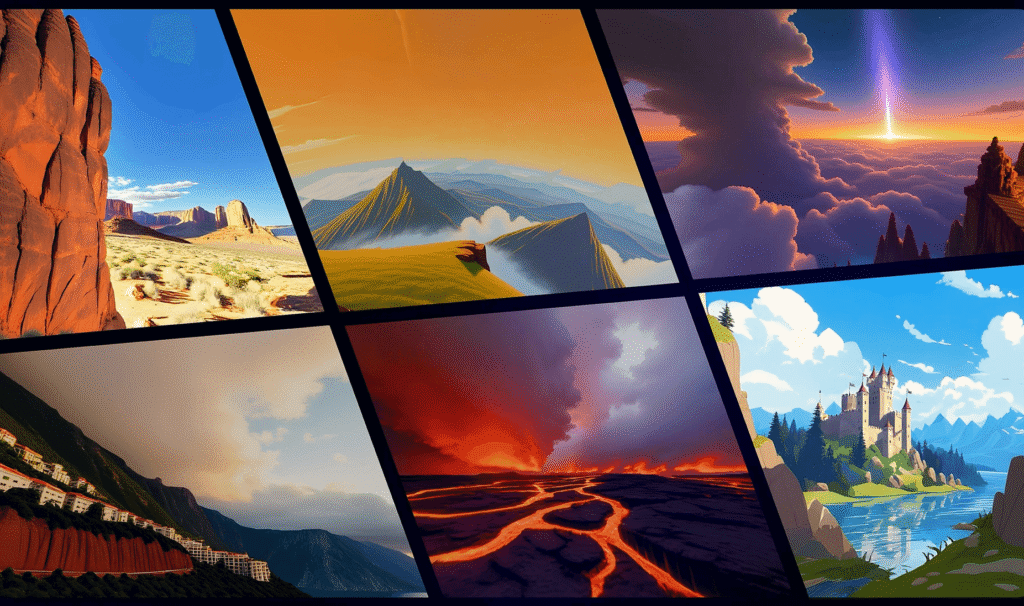From imagination to a virtual world in seconds.
Imagine typing: “a futuristic city under a purple sky, with flying cars and gleaming skyscrapers” or uploading a photo—and within seconds, having a virtual environment you can explore in 360°.
That’s what Tencent’s HunyuanWorld 1.0 promises: to create interactive, explorable 3D worlds from text or a single image, all powered by open-source artificial intelligence.
Tencent presents it as the first open-source model designed to generate 360° panoramic scenes compatible with engines like Unity and Unreal Engine.

How HunyuanWorld 1.0 Works: Technique at the Service of Creativity
The system operates in two key stages:
- Panorama Generation – It uses a diffusion-based model called Panorama-DiT to generate seamless 360° images without distortions at seams or poles.
- Hierarchical Reconstruction – From the panorama, it separates the sky, background, and objects into independent semantic layers, which are then transformed into editable 3D meshes.
These “proxy worlds” allow direct export as editable meshes, which can be manipulated inside VR environments or game engines as if they were manually built scenes.
While interaction is currently limited to panorama-style navigation (not full open-world gameplay), the potential is huge.
What Does HunyuanWorld 1.0 Bring to the Creative Industry?
- Democratized Access – As an open-source release, it includes weights, code, and integration with standard graphics pipelines—ideal for indie studios, students, and freelance creators.
- Full Compatibility – Works with Unity, Unreal, VR/AR, and simulation environments thanks to its declarative architecture and mesh exportability.
- Basic Interactivity from Day One – Objects like trees, buildings, and furniture can be manipulated independently, opening the door for prototypes, interactive storytelling, and rapid demos.
- A Starting Point for Future Innovation – Tencent also released Hunyuan3D 2.0 (textured asset generation), along with platforms like HunyuanVideo and Hunyuan-A13B language models, all open-source.
Real-World Applications: From Design to Gameplay and Simulation
Even in its early version, HunyuanWorld 1.0 is already sparking interest in:
- Game and VR design – Quickly generating cityscapes or worlds without modeling everything from scratch.
- Storytelling and architectural simulations – Creating environments from a simple phrase or visual reference.
- Prototypes for e-learning and virtual tourism – Accelerating production with instantly generated 3D experiences.
Current Limitations and Technical Challenges
At present, the model generates static panoramic scenes with limited interactivity. There’s no free movement or continuity in long videos—for that, the Voyager module or future iterations will be required.
Other challenges include: Graphic quality (textures and resolution). Geometric consistency in complex objects. Lightweight export formats for web and mobile use.
Between Hype and Reality: What Does It Mean for Creative Innovation?
This release represents a turning point. The ability to generate interactive visual worlds from scratch is no longer limited to studios with large teams of 3D artists. With just a prompt and a click, anyone can build a virtual space ready to explore.
But it also raises critical questions:
- How do we maintain visual and narrative quality control in auto-generated content?
- Where’s the balance between manual editing and AI generation?
- How can we ensure these tools enhance creativity instead of replacing it?
So… what now?
The arrival of models like HunyuanWorld 1.0 puts in our hands a tool that seemed like science fiction just five years ago: creating entire worlds from a simple idea or image. It democratizes 3D creation, shortens timelines, lowers barriers, and opens up possibilities for creators, designers, developers, and dreamers. But it also comes with responsibility:
👉 If anyone can now create a world… how do we decide which worlds are worth building?
